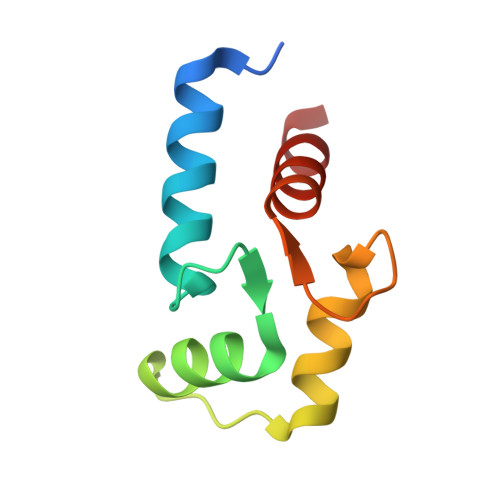Calmodulin binds to Drosophila TRP with an unexpected mode.
Chen, W., Shen, Z., Asteriti, S., Chen, Z., Ye, F., Sun, Z., Wan, J., Montell, C., Hardie, R.C., Liu, W., Zhang, M.(2021) Structure 29: 330-344.e4
- PubMed: 33326749
- DOI: https://doi.org/10.1016/j.str.2020.11.016
- Primary Citation of Related Structures:
7CQH, 7CQP, 7CQV - PubMed Abstract:
Drosophila TRP is a calcium-permeable cation channel essential for fly visual signal transduction. During phototransduction, Ca 2+ mediates both positive and negative feedback regulation on TRP channel activity, possibly via binding to calmodulin (CaM). However, the molecular mechanism underlying Ca 2+ modulated CaM/TRP interaction is poorly understood. Here, we discover an unexpected, Ca 2+ -dependent binding mode between CaM and TRP. The TRP tail contains two CaM binding sites (CBS1 and CBS2) separated by an ∼70-residue linker. CBS1 binds to the CaM N-lobe and CBS2 recognizes the CaM C-lobe. Structural studies reveal the lobe-specific binding of CaM to CBS1&2. Mutations introduced in both CBS1 and CBS2 eliminated CaM binding in full-length TRP, but surprisingly had no effect on the response to light under physiological conditions, suggesting alternative mechanisms governing Ca 2+ -mediated feedback on the channel activity. Finally, we discover that TRPC4, the closest mammalian paralog of Drosophila TRP, adopts a similar CaM binding mode.
Organizational Affiliation:
Shenzhen Key Laboratory for Neuronal Structural Biology, Biomedical Research Institute, Shenzhen Peking University-The Hong Kong University of Science and Technology Medical Center, Shenzhen 518036, China; Greater Bay Biomedical Innocenter, Shenzhen Bay Laboratory, Shenzhen 518055, China.
















